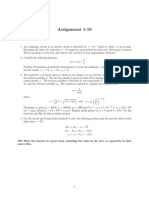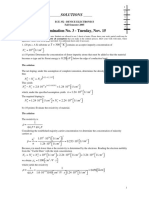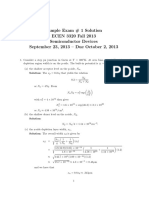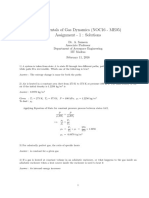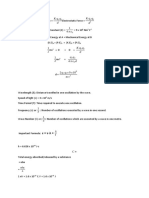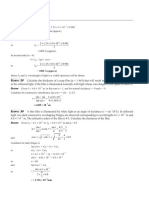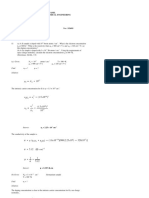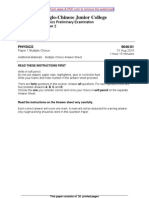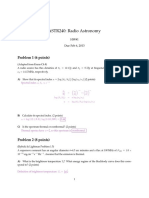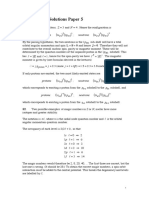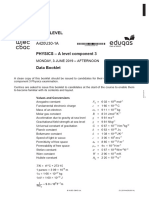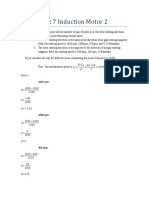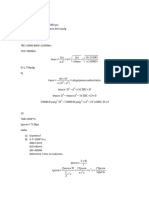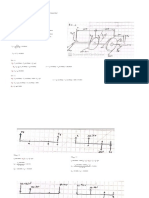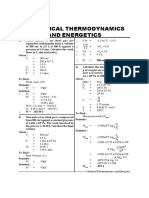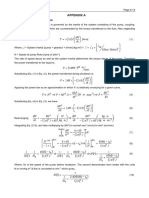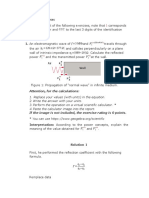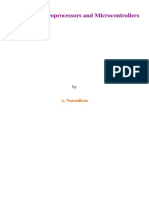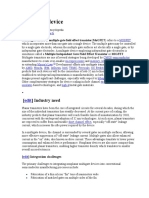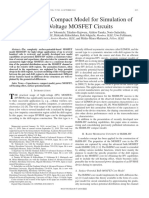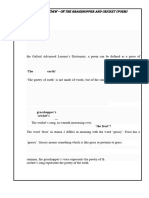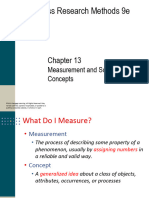Tutorial 2 Ans PDF
Tutorial 2 Ans PDF
Uploaded by
Ma SeenivasanCopyright:
Available Formats
Tutorial 2 Ans PDF
Tutorial 2 Ans PDF
Uploaded by
Ma SeenivasanOriginal Title
Copyright
Available Formats
Share this document
Did you find this document useful?
Is this content inappropriate?
Copyright:
Available Formats
Tutorial 2 Ans PDF
Tutorial 2 Ans PDF
Uploaded by
Ma SeenivasanCopyright:
Available Formats
ADVANCED MOSFET MODELING
Tutorial No: 2
1. In an uniformly doped silicon sample, the electron and hole components of current are
equal in an applied electric field. Calculate the equilibrium electron and hole
concentrations, the net doping and the sample resistivity at 300K.
µp µ
Ans: Jn = Jp (drift currents) nq µ nξ = pq µ p ξ ⇒ n = p; p= n n
µn µp
µp µn
also np = ni2 ⇒ ie n = ni ; p = ni At equilibrium ,
µn µp
ni 1.5 × 1010
∴ no = = = 8.66 × 109 / cm3 µn = 1350 cm2 / V.sec
3 3
po = 3 ni = 3 × 1010 = 2.59 × 1010 / cm 3 µp = 450 cm2/V.sec
Net doping = P0- n0 = 2.59 x 1010 – 8.66 x 109 = 1.72 x 1010 / cm3
1 1
Resistively = =
σ q (nrn + pµ p )
1
1.6 × 10 − 19
( 8.66 × 10 × 13.50 + 2.59 × 1010 × 450 )
9 = 2.68 x 105 Ω cm
2. An intrinsic sample of Ge has a resistivity of 60 Ohms.cm. Calculate the value of
current density in an applied field of 10mV/cm if 1013 donors/cm3 and 4x1012 acceptors are
introduced. Take µn = 4200 cm2/V.sec and µp = 2000 cm2/V.sec. Assume that all impurities
are ionised.
1 1 1
Ans. Intrinsic resistivity ρi = = =
σi ni q µ n + pi q µ p ni q ( µ n + µ p )
1 1
∴ ni = ρ i q(µ n + µ p ) = 60 × 1.6 × 10 − 9 (4200 + 2000)
for Ge, ni = 1.68 x 1013 / cm3
net doping = n – p = ND - NA = 1013 – 4 x 1012
n–p = 6 x 1012 / cm3 (1)
but (n – p)2 = n2 + p2 – 2 np = n2 + p2 – 2ni2
(n + p)2 = n2 + p2 + 2np = n2 + p2 + 2ni2
∴ (n + p)2 = (n - p)2 + 4ni2
∴n+p = ( n − p) 2 + 4ni 2 = (6 × 1012 ) 2 + 4 (1.68 × 1013 ) 2
n+p = 3.41 x 1013 / cm3 (2)
∴ (1) & (2) ⇒ n = 2 x 1013 / cm3 & P = 1.4 x 1013 /cm3
J = (nqµn + pqµp) ξ =q ξ (nµn + pµp)
= 1.6 x 10-19 x 10 x 10-3 (2 x 1013 x 4200 + 1.4 x 1013 x 2000) =1.792 x 10-4 A / cm2
3. A sample of intrinsic semiconductor has a resistance of 10 Ohms at 364 K and 100 Ohms
at 333 K. Assuming that mobilities are almost constant at this temperature range, calculate
the band gap of the semiconductor.
− Eg
α T
3
Ans. Intrinsic concentration ni 2
exp
2 KT
1 RA
and ρ int ri = =
ni q ( µ n + µ p ) l
R - resistance ,A - area ,l - length
3 − Eg
T1 2 exp
R ni1 2 KT1
∴ 2 = = at T = T1 = 333K, R1 = 100 Ω
R1 ni2 3 − Eg
T2 2 exp
2 KT2
T = T2 = 364K, R2 = 10Ω
− Eg 1 1
3
1 333 2
∴ = exp −
10 364 2 K T1 T2
− Eg T 333
3 3
364 2
1 T − Eg 300 300 Eg
2
× = exp − = exp − ∴ = ln 10 ×
333 10 2 KT T1 T2 .052 333 364 .675 364
Eg = .675 x 2.169 = 1.46eV
4. The resistivity of a silicon sample (ρo) is measured at 300 K. the sample is then remelted
and doped with an additional 5x1016 arsenic atoms/cm3. A new crystal is grown that has a
resistivity of 0.1 Ohm.cm and is n-type. Determine the type and concentration of dopant in
the original sample and value of ρo.
1 1 1
Ans. New crystal in n type ∴ ρi = ∴ n= = = 4.63 x 1016 / cm3
nq µ n ρ i q µ n .1× 1.6 × 10 − 19 × 1350
p = ni2/n
2.25 × 1020
net doping n-p = N D+ − N A− p= = 4860
4.63 × 1016
ni 2
∴ N A = N D+ − n +
n
= N D+ − n = (5 – 4.63) 1016
Concentration of dopants originally, NA = 3.7 x 1015 / cm3
∴Originally crystal was p type assuming all NA are ionized.
1 1
P = NA & ρo = =
P0 q µ p 3.7 × 1015 × 1.6 × 10 − 19 × 450
Original resistivity = 3.75Ωcm
5. A p-type silicon sample with a resistivity of 100 Ohms.cm at 300K is uniformly
illuminated with light that generates 1016 excess electron hole pairs (EHP) per cm3 per sec.
In the steady state, calculate the change in resistivity of the sample caused by the light. If
the light is switched off at t = 0, calculate the time required for the excess conductivity to
drop to 10% of its value at t = 0. Assume τn = 10-6 sec
1
Ans. A p-type sample, ρi = 100Ω cm
ρ p0 q µ p
1
∴ p p0 = = 1.39 × 1014 / cm 3
100 × 1.6 × 10 − 19 × 450
ni 2 2.25 × 1020
n p0 = = = 1.6 × 106 / cm 3
p p0 1.39 × 1014
p1p = n1p = GL Cn = 1010 / cm3
pp = Pp1 + Pp0 = 1.39 × 1014 / cm 3
1 1
∴ ρ = = = 99.9Ωcm
nq µ n + pqµ p 1.6 × 10 − 19
( 1.39 × 10 14
× 450 + 1010 × 1 350 )
Excess conductivity σ α P1p and n1p.
∴when excess σ drops to 10% of its initial value excess concentration (carriers) np1 or Pp1 also
drops to 10%.
n1p 10 n
∴ = = .1 But n1p = n p exp − t ∴ t = τ n ln 1p = τ n ln 10 = 2.3 × 10 − 6 sec
np 100 τn n
p
6. A silicon sample is doped with 1015 donors /cm3. Calculate the excess electron and hole
concentration required, to increase the sample conductivity by 15%. What carrier
generation rate is required to maintain these concentrations? Assume τp = 10-6 sec and T
=300 K.
2.25 × 1020
Ans. nn = 1015 / cm 3 , Pn =
1015
= 2.25 × 105 / cm 3
σ = nn q µ n = 1015 x 1.6 x 10-19 x 1350 = 0.216Ω/ cm
when σ in increased by 15%, σnew = σ + ∆σ = σ + .15 σ
σnew = 1.15σ = nn q µn + pn q µp (nn = nn + nn1 Pn = pn + pn1 = pn1 ) n1n = p1n
∴ excess conductivity
.15σ .15 × 216
σ1 = .15σ = p1nq (µn + µp) ∴ p1n = = =
q( µ n + µ p ) 1.6 × 10− 19 × (1350 + 450)
1.125 x 1014 / cm3
p1n 1.125 × 1014
GL = = = 1.125 ×
1020 / cm3 / sec
τp 10− 6
[Note: Use ni = 1.5x1010 cm-3, µn = 1350 cm2/V.s and µp = 450 cm2/V.s for silicon at 300 K]
You might also like
- Answers of Problems: Biochemical Engineering: A Textbook For Engineers, Chemists and BiologistsDocument32 pagesAnswers of Problems: Biochemical Engineering: A Textbook For Engineers, Chemists and BiologistsMcLovin .MOHNo ratings yet
- Dire-Dawa University Dire-Dawa Institute of Technology: Department of Mechanical and Industrial EngineeringDocument13 pagesDire-Dawa University Dire-Dawa Institute of Technology: Department of Mechanical and Industrial Engineeringluter alexNo ratings yet
- Sols3-4 2014Document6 pagesSols3-4 2014Anonymous Nn7rLVgPHNo ratings yet
- 5-Minute Daily Practice - Writing (NRevill v1)Document64 pages5-Minute Daily Practice - Writing (NRevill v1)Cristina Liliana93% (15)
- AttachmentDocument1 pageAttachmentMuhammet CakmakNo ratings yet
- Exam Solution 3Document5 pagesExam Solution 3Vu VoNo ratings yet
- SE1Soln Gate EceDocument8 pagesSE1Soln Gate EcearvindfNo ratings yet
- Gas Dynamics - Assignemt SolutionsDocument53 pagesGas Dynamics - Assignemt SolutionsSsheshan Pugazhendhi100% (1)
- Chem 6A - F20 Final Exam Equation SheetDocument3 pagesChem 6A - F20 Final Exam Equation Sheetlildick001No ratings yet
- hw7 AnsDocument6 pageshw7 Anssyifa annisa siraitNo ratings yet
- DC PandeyDocument137 pagesDC Pandeyanshuman.panda.odmNo ratings yet
- Mcde S16Document30 pagesMcde S16puceiroaleNo ratings yet
- Potential EnergyDocument10 pagesPotential Energyjohn soniNo ratings yet
- 63ufrep 13.EC FullSyllabusPaper-II (Solutions)Document42 pages63ufrep 13.EC FullSyllabusPaper-II (Solutions)Saty Prakash YadavNo ratings yet
- Interference Split (48 48) 20231105100344Document1 pageInterference Split (48 48) 20231105100344primeanshumalikashyapNo ratings yet
- ATS Exercise Sol EDocument24 pagesATS Exercise Sol EMeenakshiSundareshNo ratings yet
- The Citadel Department of Electrical Engineering: Find: SolutionDocument12 pagesThe Citadel Department of Electrical Engineering: Find: SolutionTuấn VũNo ratings yet
- Additional Solved Problems For TextDocument58 pagesAdditional Solved Problems For TextKIMBERLY ANNE DIAZNo ratings yet
- 2010 H2 Prelim Papers With Answers (9646) Papers 1, 2 and 3Document1,304 pages2010 H2 Prelim Papers With Answers (9646) Papers 1, 2 and 3Yeo Cuthbert80% (5)
- Solutions For HW #2 Problem 1 (1.2 in The Textbook) : N C V N N V VDocument3 pagesSolutions For HW #2 Problem 1 (1.2 in The Textbook) : N C V N N V VAzhar MahmoodNo ratings yet
- ASTR240: Radio Astronomy .Hw1-SolnsDocument7 pagesASTR240: Radio Astronomy .Hw1-SolnsmzmohamedarifNo ratings yet
- A2 Physics 9702 Paper 4 FinalDocument30 pagesA2 Physics 9702 Paper 4 FinalMusic GidrosiaNo ratings yet
- Solutions 5 XDocument3 pagesSolutions 5 XRoy VeseyNo ratings yet
- Chem 6A - F20 Exam 2 Equation SheetDocument2 pagesChem 6A - F20 Exam 2 Equation Sheetlildick001No ratings yet
- Fpy 0316 - Mid Sem 1 (2021-22) QuestionDocument11 pagesFpy 0316 - Mid Sem 1 (2021-22) QuestionDurga ShrieNo ratings yet
- Fourier Series of Periodic Discrete-Time SignalsDocument36 pagesFourier Series of Periodic Discrete-Time SignalsBruce MarshallNo ratings yet
- AJC 2010 JC2 H2 Physics Prelim P3 QPDocument20 pagesAJC 2010 JC2 H2 Physics Prelim P3 QPcjcsucksNo ratings yet
- Component 3Document6 pagesComponent 3lordvolderexNo ratings yet
- Electrostatics 05mar2024 CBSE SolDocument5 pagesElectrostatics 05mar2024 CBSE Solholaheg352No ratings yet
- 2023 BPH OanswerbookletsDocument18 pages2023 BPH Oanswerbookletsliumeilin20070625No ratings yet
- Physics 9702 Paper 4Document32 pagesPhysics 9702 Paper 4Alvin VictorNo ratings yet
- Assignment2 Sol PDFDocument4 pagesAssignment2 Sol PDFJLNo ratings yet
- Homework 7 - de La CruzDocument8 pagesHomework 7 - de La CruzAlvaro De La CruzNo ratings yet
- 7. A) Diámetro si B) Diametro eje es hueco dint=1pulg: τmax tbc π τmaxπ DDocument3 pages7. A) Diámetro si B) Diametro eje es hueco dint=1pulg: τmax tbc π τmaxπ DJAVIER ANDRES LOBO ACU�ANo ratings yet
- Oy Oy OyDocument4 pagesOy Oy OyCarlos S. VásquezNo ratings yet
- Fundamentals of Microelectronics - Solution ManualDocument1,115 pagesFundamentals of Microelectronics - Solution Manual박대민No ratings yet
- JC2 Physics H2 2018 RafflesDocument88 pagesJC2 Physics H2 2018 RafflesVarshLokNo ratings yet
- C7.Answers HoangDocument15 pagesC7.Answers Hoanghuyhoangpham1747No ratings yet
- ICAR UG Physics 22 September 2020 Shift 1 Solutions and Solved PaperDocument107 pagesICAR UG Physics 22 September 2020 Shift 1 Solutions and Solved PaperLibgenNo ratings yet
- Unit IIIDocument16 pagesUnit IIIUma BotsaNo ratings yet
- I1651566121ssolutions of Sample Question Paper-2Document18 pagesI1651566121ssolutions of Sample Question Paper-2jsrppoonamgeminiNo ratings yet
- ST11 # 07(Sol)Document3 pagesST11 # 07(Sol)b87479006No ratings yet
- Week 1: Introduction: NM NM Ev Ev E DT T P EDocument9 pagesWeek 1: Introduction: NM NM Ev Ev E DT T P EInstituto Centro de Desenvolvimento da GestãoNo ratings yet
- 3 Chemical Thermodynamics and Energetics PDFDocument12 pages3 Chemical Thermodynamics and Energetics PDFKD TechnicalNo ratings yet
- Exerc Cios Resolvidos - Cap. 02-Atkins FabioDocument49 pagesExerc Cios Resolvidos - Cap. 02-Atkins FabioMarilene SantosNo ratings yet
- 8b. Mock Test Jee-ADV (2018-P2) Key Sol SDocument14 pages8b. Mock Test Jee-ADV (2018-P2) Key Sol Snapewab849No ratings yet
- PHY1032S ClassTest3-2020Document2 pagesPHY1032S ClassTest3-2020lukhanyisojikela12No ratings yet
- Cambridge International AS & A Level: PHYSICS 9702/43Document24 pagesCambridge International AS & A Level: PHYSICS 9702/43Ramadhan AmriNo ratings yet
- Physics Exam V3 1617Document16 pagesPhysics Exam V3 1617lydiaisthegreatestNo ratings yet
- DT DN J T J J J: Appendix A Rate of Pump DecelerationDocument3 pagesDT DN J T J J J: Appendix A Rate of Pump Decelerationvijay_jvNo ratings yet
- Cambridge International AS & A Level: PHYSICS 9702/42Document24 pagesCambridge International AS & A Level: PHYSICS 9702/42Ramadhan AmriNo ratings yet
- Solutions of Exercises and Problems: AppendixDocument98 pagesSolutions of Exercises and Problems: Appendixvasudevan m.vNo ratings yet
- Uhorwfvnuohrafvn 8 Honvrf 8 UDocument24 pagesUhorwfvnuohrafvn 8 Honvrf 8 Uk24xnzp2qyNo ratings yet
- Cambridge International AS & A Level: PHYSICS 9702/41Document24 pagesCambridge International AS & A Level: PHYSICS 9702/41with love, alisha.No ratings yet
- IB Physics Data BookletDocument16 pagesIB Physics Data Bookletzoe campbellNo ratings yet
- HW #8 - SolutionDocument2 pagesHW #8 - SolutionMatty JakeNo ratings yet
- EE130 Discussion 2 NotesDocument4 pagesEE130 Discussion 2 NotesSaied Aly SalamahNo ratings yet
- Annex 2 - TeoríaDocument7 pagesAnnex 2 - Teoríakevin narvaez henriquezNo ratings yet
- Tutorium Compressor Solution PDFDocument12 pagesTutorium Compressor Solution PDFArif SabainNo ratings yet
- Advanced Microprocessors and Microcontrollers: A. NarendiranDocument14 pagesAdvanced Microprocessors and Microcontrollers: A. NarendiranMa SeenivasanNo ratings yet
- Test 3 Prob ListDocument1 pageTest 3 Prob ListMa SeenivasanNo ratings yet
- SDocument19 pagesSMa SeenivasanNo ratings yet
- LDocument16 pagesLMa SeenivasanNo ratings yet
- Digital WatermarkingDocument6 pagesDigital WatermarkingMa SeenivasanNo ratings yet
- Hot Carrier Injection: Reductions in Device Dimensions Without Corresponding Reductions in Operating VoltagesDocument16 pagesHot Carrier Injection: Reductions in Device Dimensions Without Corresponding Reductions in Operating VoltagesMa SeenivasanNo ratings yet
- Multigate Device: Industry NeedDocument4 pagesMultigate Device: Industry NeedMa SeenivasanNo ratings yet
- MOS Assignment 2Document1 pageMOS Assignment 2Ma SeenivasanNo ratings yet
- Modelling of Power MOSFET For The Analysis of Switching Chara in Half-Bridge ConvertersDocument10 pagesModelling of Power MOSFET For The Analysis of Switching Chara in Half-Bridge ConvertersMa SeenivasanNo ratings yet
- M.E. VLSI and Applied Electronics Advanced MOSFET Modelling Assignment 1 Due Date: 31 01 2011Document1 pageM.E. VLSI and Applied Electronics Advanced MOSFET Modelling Assignment 1 Due Date: 31 01 2011Ma SeenivasanNo ratings yet
- HiSIM-HV - A Compact Model For Simulation of High-Voltage MOSFET CircuitsDocument8 pagesHiSIM-HV - A Compact Model For Simulation of High-Voltage MOSFET CircuitsMa SeenivasanNo ratings yet
- 1.1 Background of The StudyDocument9 pages1.1 Background of The StudyPrem Kirati100% (1)
- Understanding Culture, Society and PoliticsDocument11 pagesUnderstanding Culture, Society and PoliticsZeneah MangaliagNo ratings yet
- Test Reading 1Document2 pagesTest Reading 1Mahdi KhaliliNo ratings yet
- Guidelines and Application Form For Oil and Gas Industry Service PermitDocument13 pagesGuidelines and Application Form For Oil and Gas Industry Service PermitOlatunde Olusegun Raphael75% (4)
- Declaratie de Conformitate CE Camera Supraveghere Exterior IP Dahua IPC-HFW5541T-ASE-0280BDocument2 pagesDeclaratie de Conformitate CE Camera Supraveghere Exterior IP Dahua IPC-HFW5541T-ASE-0280BLaurentiu LutaNo ratings yet
- ROM - SEA Complete Book For Additional Attack Ultimate Guide-SheetDocument11 pagesROM - SEA Complete Book For Additional Attack Ultimate Guide-SheetHurtlock HurtlockNo ratings yet
- Keda Case ReportDocument4 pagesKeda Case ReportShaurya SharmaNo ratings yet
- Entrepreneurship Class Xii Worksheet - Chapter 1 - Entrepreneurial OpportunityDocument3 pagesEntrepreneurship Class Xii Worksheet - Chapter 1 - Entrepreneurial OpportunityHarshit JagetiaNo ratings yet
- English 8Document58 pagesEnglish 8manas singhNo ratings yet
- Lists of Manlilikha NG Bayan G2Document26 pagesLists of Manlilikha NG Bayan G2tjhunter077No ratings yet
- RHB Indonesia Middle Class Outlook 2024Document5 pagesRHB Indonesia Middle Class Outlook 2024dodiasukiNo ratings yet
- General General General General Description Description Description DescriptionDocument8 pagesGeneral General General General Description Description Description DescriptionkksandeepNo ratings yet
- Submitted in Partial Fulfilment For The Award of The Degree ofDocument64 pagesSubmitted in Partial Fulfilment For The Award of The Degree ofSahilGuptaNo ratings yet
- Hospital ProfileDocument3 pagesHospital ProfilePrakruti Care Hospital & IccuNo ratings yet
- Recon For Web Pen-TestingDocument17 pagesRecon For Web Pen-TestingEllisNo ratings yet
- Nature of Belief! - AtranDocument1 pageNature of Belief! - AtranNicanor RodriguezNo ratings yet
- Maya Rochefort Resume 2017Document1 pageMaya Rochefort Resume 2017api-351859634No ratings yet
- 5 - Measurement and Scaling Concepts - SDocument15 pages5 - Measurement and Scaling Concepts - Ssiaowei0132No ratings yet
- Refrigeration-Systems Part 1Document11 pagesRefrigeration-Systems Part 1Sean GuanzonNo ratings yet
- 3 Job Shop Scheduling PDFDocument7 pages3 Job Shop Scheduling PDF123away123No ratings yet
- 2022 CHIL Institute Training Prospectus - RepsDocument19 pages2022 CHIL Institute Training Prospectus - RepsIsaacAitalegbeNo ratings yet
- Suggested Script Layout: by Dora SmithDocument4 pagesSuggested Script Layout: by Dora Smithcwalkeroakgrove100% (1)
- BulletDocument18 pagesBulletDeepuNo ratings yet
- 100 C Program SolutionDocument56 pages100 C Program SolutionKunal KoushikNo ratings yet
- Chapter4 TransDocument104 pagesChapter4 TransAbdul Shukor100% (1)
- Urn - Isbn - 978 952 61 0299 3Document286 pagesUrn - Isbn - 978 952 61 0299 3Roy Bhardwaj100% (1)
- Van Dijk From Text Grammar To Critical Discourse AnalysisDocument13 pagesVan Dijk From Text Grammar To Critical Discourse AnalysisEtruscus RosNo ratings yet
- E - MURAL PLAZA (7 Units) 03-07-19-Model E-1Document1 pageE - MURAL PLAZA (7 Units) 03-07-19-Model E-1Engr M.Arshad KhalidNo ratings yet
- APPLE Marketing StrategyDocument38 pagesAPPLE Marketing StrategyThái HườngNo ratings yet




